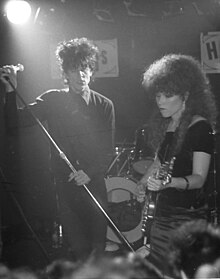Gothabilly (sometimes hellbilly[1]) is music genre influenced by rockabilly and the goth subculture. The name is a portmanteau word that combines gothic and rockabilly, first used by the Cramps in the late 1970s to describe their somber blend of rockabilly and punk rock.[1][2] Since then, the term has come to describe a fashion style influenced by gothic fashion, as seen in its use of black silks, satins, lace and velvet, corsets, top hats, antique jewellery, PVC, and leather.[1]
Characteristics
editGothabilly is distinctly different in sound from psychobilly, as while psychobilly fuses 1950s rockabilly with 1970s punk rock in a faster, more aggressive sound, gothabilly fuses bluesy rockabilly with gothic piano and guitar, and is defined by having slower tempos and emphasizing mood over aggression.[1]
History
editThe Cramps have been credited with coining the term "gothabilly".[1] The term was not popularized until the release of a series of international gothabilly compilation albums released by Skully Records in the mid-1990s.[3][4]
Gothabilly is particularly active in the western portion of the United States, with many of today's bands originating in California.[5]
References
edit- ^ a b c d e Hendrickson, Meagan (March 5, 2009). "An introspective into gothabilly". Auxiliary Magazine. Archived from the original on November 29, 2022. Retrieved November 29, 2022.
- ^ Uutela, Deanna (October 4, 2007). "Case of the Zombies". Eugene Weekly. Eugene, Oregon. Archived from the original on April 30, 2009. Retrieved April 16, 2009.
- ^ Valarie Thorpe: Interview with Ghoultown's Count Lyle, reallyscary.com. Retrieved on April 14, 2009
- ^ Kirst, Sean (October 31, 2007). "A Halloween Greatest Hit...The Tale of Skully Records". The Post-Standard. Syracuse, New York. Retrieved April 16, 2009.
- ^ Johnson, Daniel (April 9), "The Growth of Gothabilly", RSEE, Riverside County, CA.
